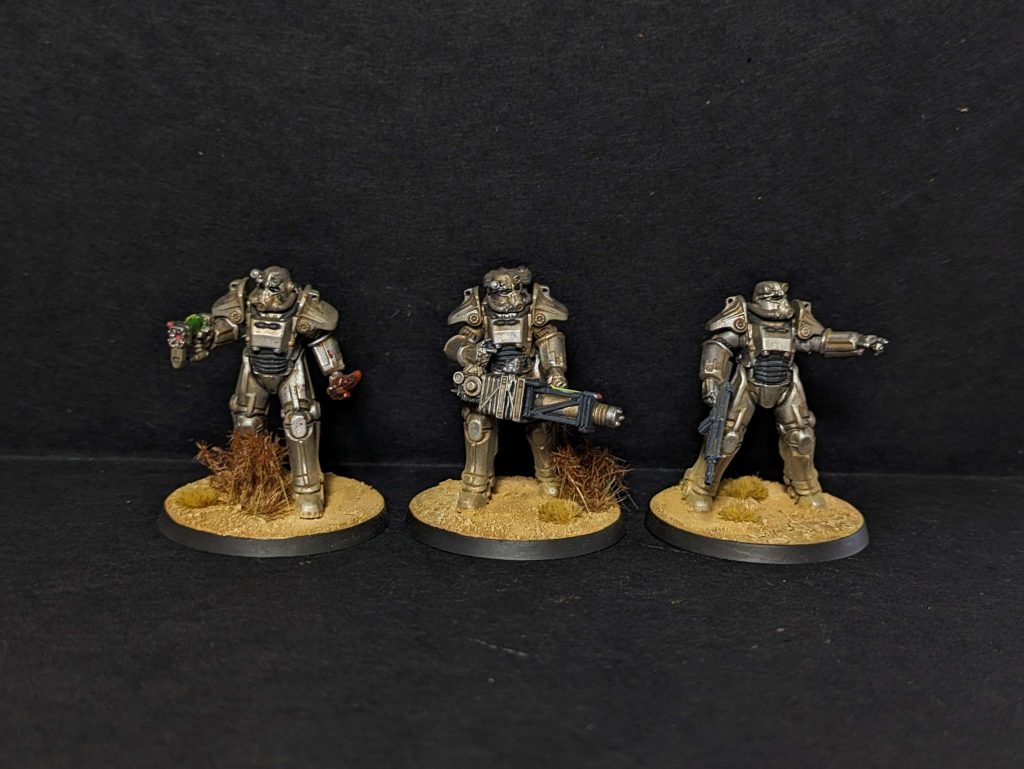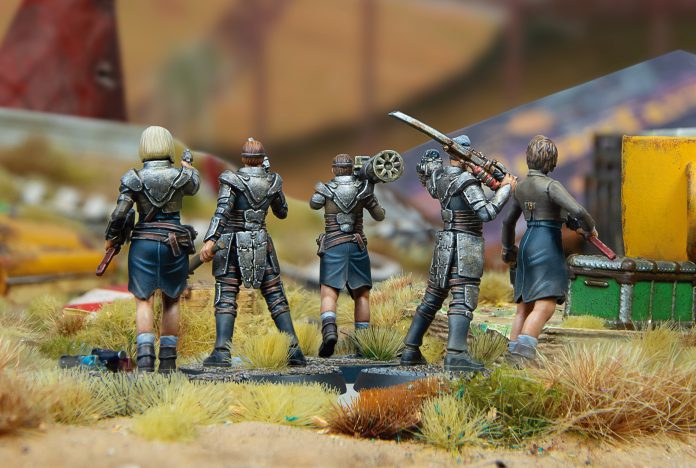When I attended the Fallout Factions launch event a few weeks back I was lucky enough to get a chance to sit down with James Hewitt, the designer, for a few minutes and ask him some questions about the game and the direction of travel. Let’s dive in:
GH: Fallout Factions is coming into a quite crowded market space. There’s obviously another Fallout miniatures game already from Modiphius, but also it’s landing in a wider market that’s quite crowded in terms of skirmish sized games. What do you see as setting Factions apart from the competition?

James: I’m willing to put my reputation on the line here – I think that this has got one of the tastiest action economies in a skirmish game. What I mean by that is that if you strip back the theme, the perks, all the nitty-gritty cool stuff that goes on top, the core question you’re asked is how much do you want to do in a turn and what are the consequences of that? It’s a game that lets a player put it all on the line and do something cool, or fail spectacularly.
In general when you play it, if you lose you know why you lost. Sometimes, of course, it’s because you rolled appalling dice, but the majority of the time it’s like actually, no, I overextended or I did this or I did that. And I think it gets to that point in a much more streamlined way than a lot of other games that do similar things.
And that is in no small part due to the amount of development the game’s had. I’ve been working on this for about three years, give or take – on and off, with other projects – but for the last year I’ve been at Modiphius and we have a dev team who are all superstars, all working really hard, all testing it, developing it. And it’s really benefited from that I think.
So for me the big selling point is this is a game that you can teach your friends in no time at all, but with your experienced gamer mates you have a really chunky puzzle to sink your teeth into. And then you add all the interesting Fallout theme on top and it’s a whole different thing.
You mentioned Wasteland Warfare – we wanted to set a real clear divide between the two. They stand side by side on the shelf, Wasteland Warfare isn’t being replaced. Factions is your accessible, head to head game – there’s no cooperative mode, like in Wasteland Warfare. It’s simple to learn, by the end of the first round you’ll understand the game, but then there’s a lot to go into for it.
And you’ll finish a game in half an hour on a 2×3 space, and then you can play more games. I think it’s going to be real darling of the organised play circuit – that’s what I hope. Especially when we’ve got lots of plans for new units, new factions, new things. It’s got legs.
GH: So new units, new factions – can you talk about that?
James: Probably! So obviously the first wave is three sets of raiders, they’re all fairly similar. And they came first – they were always the original plan, and then the game was built of the idea that we have a contained environment with three similar gangs. This feels like a skirmish gang-based wargame! But of course we’ve got the get you by lists for the Brotherhood of Steel, the Super Mutants, Wasteland Raiders and Wastelanders, each of which is a full new faction and is fully playable right now. Even before it’s released people have been reverse engineering the game from the quickstart and gameplay videos.
Beyond that? Other things in Fallout! It will be forthcoming.
[Lupe: Since this interview Modiphius have announced that these get you by lists will be printed in a full core book later this year, and there will also be a matched play only list for the upcoming Cult of the Mothman release, the first of a number of “competitive” lists.]

GH: So we saw some exciting news with the announcement of miniatures for the Fallout TV show – those have a place in Factions?
James: They have rules in Factions. Now, the pedants among us will say “but hey James, the Fallout TV show takes place a good twelve years after the events of Nuka-World, and in a different part of the country! Why are there rules for them here?” To which I would say: we’re not going to stop you. If you want to be a thematic person who just wanted to stick to the core gangs, then the rules for the TV miniatures, which we call Wasteland Wanderers, individual miniatures who join your crew for a game, those rules are optional. Both players have agree to use them. And if you decide you don’t want to have them turn up, we’re not going to force you to. But for those who want to, the option’s there.

GH: One of the things that Modiphius has pushed with your involvement in the game is your connection to Necromunda. I think anyone who plays this game can see some of the inspiration you’ve brought from Necromunda. But obviously Necromunda isn’t by any stretch of the imagination the only thing you’ve designed. So what have you brought from previous projects that aren’t Necromunda? What did you find inspiration from in them?
James: A lot of the game actually comes from Betrayal at Calth, which I think is up to about thirteen people who have played it now, which is nice? [both laugh] The way the activation system works – in Betrayal at Calth a unit has two activations in a turn and you can spread them across the round, in this that’s an optional thing so you can do all your actions at one time or spread them. Also the weapon system – in that game we said all weapons are just a number of dice and a critical effect you can trigger. There’s a couple of extra little things, range and things, but something like a combat rifle, a handmade rifle and hunting rifle are all broadly similar, but their critical effects are all unique and different. And that’s the big thing – it’s simplicity, but with a little cool thing that when it happens makes that gun feel unique. So that’s Betrayal at Calth.
I think Blitz Bowl is an interesting point of reference, because Blood Bowl, like Wasteland Warfare, is a game with a big accessibility barrier, in that it’s a very complex game and learning it kind of hurts? You have to play a lot of games where you don’t quite know what’s going on and you lose a lot, and then you get into it and you realise there’s a lot of depth here and I’m going to learn a lot more of the things and have a very granular time. So when I designed Blitz Bowl, I was trying to distil that – what is the essence of the thing, how do I make a game with that from scratch? That’s kind of what’s happening here.
One of the big influences actually, not a game I worked on, but a big one, is Blades in the Dark, which is a roleplaying game. And this game [Factions] has a downtime system – between games you make two downtime actions. In Necromunda you can do all this stuff and it can be quite overwhelming, so let’s just shrink it down and do just two of these things. Which a) puts a clutch on how much can be done and forces some interesting decisions, and b) it takes much less time.
Thanks so much to James for taking the time to answer some of our questions. The Fallout Factions starter set is up for pre-order now.


